![]()
![]()
![]()
Use LEFT and RIGHT arrow keys to navigate between flashcards;
Use UP and DOWN arrow keys to flip the card;
H to show hint;
A reads text to speech;
32 Cards in this Set
- Front
- Back

|
-Coffin of Tutankhamen, Egypt, 18th Dynasty, c. 1327 BCE. -gold inlaid with enamel and semi-precious stones -hacked mummy apart and found amulets and jewelry all over |
|
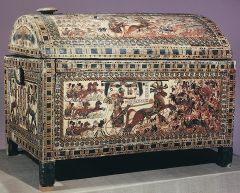
|
-Painted chest, from the tomb of Tutankhamen, Egypt, 18th Dynasty -King Tut presents himself as a great warrior on the front panel, taking over all of the victims, on the top he is shown as a hunter killing animals (probably didn’t do either of these) |
|
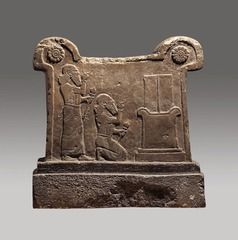
|
-Altar of Tukulti-Ninurta I, from Assur, 1244-1208 BCE -The king is depicted twice: Standing and kneeling before the altar. -The god, Nusku, is represented here as a symbol rather than in anthropomorphic form. |
|
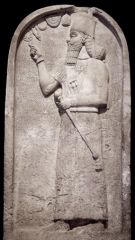
|
-Stele of Assurnasirpal II, From Nimrud, Neo-Assyrian, 883-859 BCE -The king is shown worshipping the gods in symbolic form. -The helmet with horns = Assur -The winged disc = the sun god, Shamash -The crescent within a circle = the moon god, Sin -The fork/thunderbolt = the storm god, Adad -The planet = Ishtar, goddess of love and war |
|
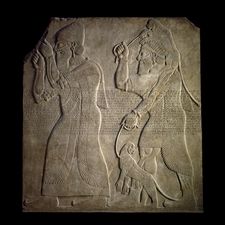
|
-Tribute-bearers with monkeys, Stone Panel from the North-West, Palace of Assurnasirpal II, Nimrud, Neo-Assyrian, 883-859 BCE -Assyrian kings commissioned panels to decorate the mud-brick walls in palaces and temples. -bringing in gifts/money (hunting/warfare) -comic book some are 8.5 feet tall |
|
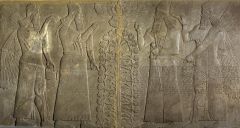
|
-Assurnasirpal being blessed by a genius, Stone Panel from the North-West Palace of Assurnasirpal II, Nimrud, Neo-Assyrian, 883-859 BCE -Ashurnasirpal appears twice, asher is tending to the tree of life. Gods are watching. |
|

|
-The escape of enemies across a river, Stone Panel from the North-West Palace of Assurnasirpal II, Nimrud, Neo-Assyrian, 883-859 BCE -enemy trying to escape -enemies with rounded hats -some have jumped into the river to save themselves |
|

|
-Lamassu (winged human-headed bull), from the citadel of Sargon II, Khorsabad, Neo-Assyrian, c. 720-705 BCE -usually placed in doorways, spiritual guards protecting -winged bulls, human heads, feline feet body of a bull, wings, bearded face -headdress: horned symbolizes god, associated with divine/protective -Features five legs to show two difference stances: from the front, they appear to stand still. From the side, they appear to be walking. -cuneiform inscription: prayer for his welfare, and a curse on anyone who defaces his statues. |
|

|
- Gilgamesh Wrestling Lion, from the citadel of Sargon II, Khorsabad, Neo-Assyrian, c. 720-705 BCE -cylinder seal -assyrians obsessed with Gilgamesh -hero=lion slayer |
|
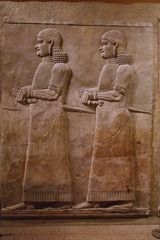
|
-Courtiers facing Sargon, from the citadel of Sargon II, Throne Room, Khorsabad, Neo-Assyrian, c. 720-705 BCE - |
|
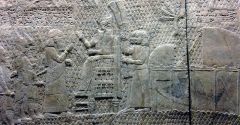
|
-Sennacherib on throne (detail), from Capitulation of Lachish relief, Nineveh, Neo-Assyrian, 8th c. BCE - |
|
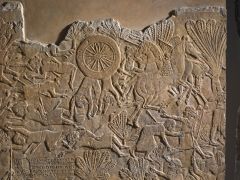
|
-Battle of Til Tuba in Elam, Nineveh (Alabaster Wall Relief) -scene of war, story over time over extended space, continuous narrative, vertical perspective -hill on left scene, river flowing on right (flows left to right) -2 leaders thrown out of chariot (no longer powerful, helpless) King's hat falling off, arrow in his back, being killed and decapitated |
|

|
-The “Garden Party” Relief, Nineveh (Alabaster relief) -banquet outside in a garden -King shown at highest point, Queen w/ King which is rare to see -peaceful victory scene -reminder of what happened, King's head hanging |
|

|
-Assurbanipal hunting lions and gazelles, Nineveh, relief panel -lion charging toward king, continuous narrative -same lion, brought in and caged, hand to hand combat -King stabbing the lion, controlled event |
|
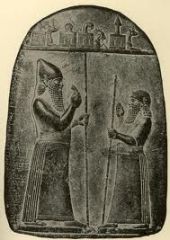
|
-Kudurru (Boundary Stone) of Mardukapaliddina, Babylonian, 714 BCE
|
|
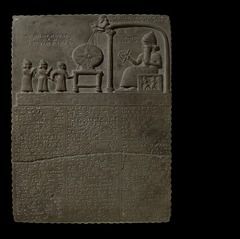
|
-“Tablet of Shamash”, From Sippar -restoration of Sun-god's image and temple -sun-god seated under an awning & holding the rod & ring (symbols of divine authority) |
|

|
-Throne Room façade, from Nebuchadnezzar II's Babylon -polychrome, glazed bricks,decorative elements -lion (bottom) divine symbol of Inana/Ishtar: patron goddess -Rosettes -mixing with western world, ionic columns (with swirls) originate in Greece |
|
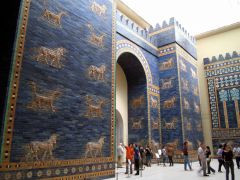
|
-Ishtar Gate, from Babylon -glazed brick -compare to cone mosaics from Uruk -in a museum
|
|
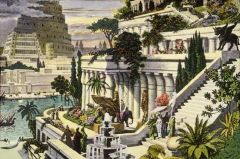
|
-Hanging Gardens of Babylon and “Tower of Babel” Neo-Babylonian -rectangular, each side consisting of arched balls/stone columns -roots of trees were on terrorists -legend idea that they were royal gardens -"The garden was 100 ft long by 100 ft wide & built up in tiers so that it resembled a theatre" |
|

|
-Gold figurine of a god, from Anatolia, Hittite -high pointed hat, short-skirted robes, boots w/ long curled toes -Teshub, storm god, symbol of the bull |
|
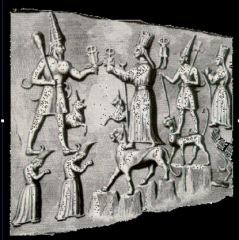
|
-Union of Teshub and Hepat, main scene at Great Sanctuary of Yazilikaya, from Anatolia, Hittite -union of supreme couple, teshub stands on 2 mountain gods & hepat stands on a panther, son behind them |
|

|
-Lion Gate, Southwestern entrance to Hattusha, Anatolia, c. 1343-1200 BCE -stone walls -doorways were formed with mud-brick -bad shape/crumbling walls -reminder of Camassu guardian/guards figures |
|
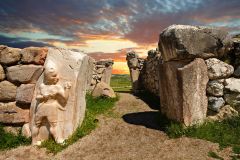
|
-King’s Gate, Northeastern entrance to Hattusha, Anatolia, c. 1343-1200 BCE -on corresponding side of Lion's gate -horned helmet, holding a weapon -protector |
|
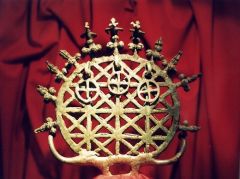
|
-“Sun Disk”, Hatti ceremonial standard, from Alaça Hoyuk, Anatolia, 3rd millennium BCE -bronze -ceremonial standards -attached to a pole -buried with deceased, built in rattles |
|
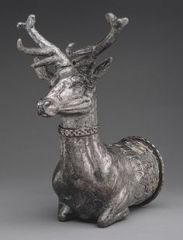
|
-Stag Rhyton, Anatolia, Hittite Empire, c. 14th–13th century BCE -silver with gold inlay -ceremonial vessel -rhyton: hornlike drinking vessel shaped like an animal -repousse
|
|
|
Rhyton |
A hornlike drinking vessel of ancient times, often having a pointed end shaped like an animal or animal's head. |
|
|
Auroch |
Extinct wild ox of the Near East and Europe, the species from which cattle are probably descended. |
|
|
Kudurru |
Stele that served as a record of a land grant issued by a Babylonian king to a particular person, official, priest or temple. |
|
|
Scarab |
A large dung beetle of the eastern Mediterranean area, regarded as sacred in ancient Egypt. |
|
|
Block Statue |
A popular sculptural type in the Egyptian New Kingdom where the seated figure is depicted with his knees drawn up to his chest and wrapped in a cloak. |
|
|
Continuous Narrative |
A type of narrative that illustrates multiple scenes within a single frame. |
|
|
Lamassu |
Monumental human-headed, winged bull that guarded the entrances to palaces and temples. |

